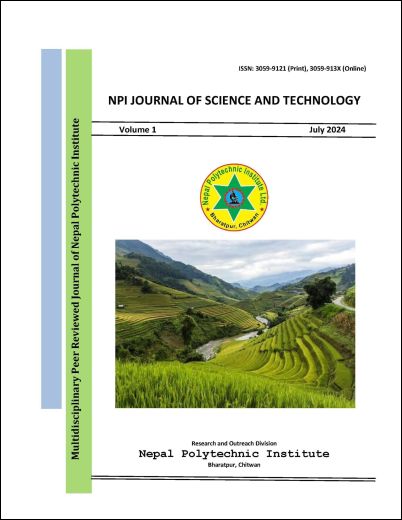In vitro Evaluation of Efficacy of Fungicides Against Fusarium oxysporum f. sp. Lycopersici (Sacc.) Synder and Hansen Causing Wilt Disease of Tomato
DOI:
https://doi.org/10.3126/npijst.v1i1.68938Keywords:
Fusarium wilt, in vitro, Carbendazim, inhibitionAbstract
Fusarium wilt of tomato caused by Fusarium oxysporum f.sp. lycopersici is one of the most devastating and economically important fungal diseases of tomatoes. The study was conducted to assess the effectiveness of commercially available fungicides against Fusarium oxysporum f. sp lycopersici, a Nepali isolate by poisoned food technique. The experiment was carried out in a Completely Randomized Design (CRD) with five replications, in the Plant Protection Laboratory of the Ministry of Industry, Agriculture and Cooperatives, Jhumka, Sunsari. Six different fungicides: Mancozeb, Copper oxychloride, Carbendazim, Azoxystrobin, Kasugamycin + Copper oxychloride, Azoxystrobin + Difenoconazole at four different concentrations (100 ppm, 150 ppm, 200 ppm and 250 ppm) were tested for their ability to inhibit mycelial growth of the fungus, in vitro. The mycelial growth of the fungus was measured at 2, 4, 6, 8 and 10 days after inoculation (DAI). Among these fungicides Carbendazim, at all concentrations, showed the highest mycelial growth inhibition (100%) followed by Azoxystrobin in combination with Difenoconazole (82.79%) and Azoxystrobin alone (61.04%) at 250 ppm on 10 DAI. The results suggest that Carbendazim was the most effective at the lowest concentration (100 ppm) at in vitro inhibition of the fungus. Therefore, it can be a candidate to be explored for in vivo management of fusarium wilt of tomato caused by Fusarium oxysporum f.sp. lycopersici.
Downloads
Downloads
Published
How to Cite
Issue
Section
License
All rights reserved. No part of this publication may be reproduced, distributed, or transmitted in any form or by any means, including photocopying, recording, or other electronic or mechanical methods, without the prior written permission of the publisher, except in the case of brief quotations embodied in critical reviews and certain other non-commercial uses permitted by copyright law.




